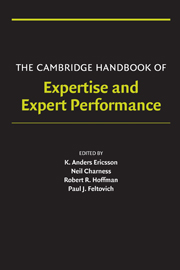Book contents
- Frontmatter
- Contents
- Acknowledgments
- Contributors
- PART I INTRODUCTION AND PERSPECTIVE
- PART II OVERVIEW OF APPROACHES TO THE STUDY OF EXPERTISE – BRIEF HISTORICAL ACCOUNTS OF THEORIES AND METHODS
- PART III METHODS FOR STUDYING THE STRUCTURE OF EXPERTISE
- PART IV METHODS FOR STUDYING THE ACQUISITION AND MAINTENANCE OF EXPERTISE
- PART V DOMAINS OF EXPERTISE
- PART V.A PROFESSIONAL DOMAINS
- PART V.B ARTS, SPORTS, & MOTOR SKILLS
- 26 Music
- 27 Expert Performance in Sport: A Cognitive Perspective
- 28 Artistic Performance: Acting, Ballet, and Contemporary Dance
- 29 Perceptual-Motor Expertise
- PART V.C GAMES AND OTHER TYPES OF EXPERTISE
- PART VI GENERALIZABLE MECHANISMS MEDIATING EXPERTISE AND GENERAL ISSUES
- Author Index
- Subject Index
- References
27 - Expert Performance in Sport: A Cognitive Perspective
from PART V.B - ARTS, SPORTS, & MOTOR SKILLS
- Frontmatter
- Contents
- Acknowledgments
- Contributors
- PART I INTRODUCTION AND PERSPECTIVE
- PART II OVERVIEW OF APPROACHES TO THE STUDY OF EXPERTISE – BRIEF HISTORICAL ACCOUNTS OF THEORIES AND METHODS
- PART III METHODS FOR STUDYING THE STRUCTURE OF EXPERTISE
- PART IV METHODS FOR STUDYING THE ACQUISITION AND MAINTENANCE OF EXPERTISE
- PART V DOMAINS OF EXPERTISE
- PART V.A PROFESSIONAL DOMAINS
- PART V.B ARTS, SPORTS, & MOTOR SKILLS
- 26 Music
- 27 Expert Performance in Sport: A Cognitive Perspective
- 28 Artistic Performance: Acting, Ballet, and Contemporary Dance
- 29 Perceptual-Motor Expertise
- PART V.C GAMES AND OTHER TYPES OF EXPERTISE
- PART VI GENERALIZABLE MECHANISMS MEDIATING EXPERTISE AND GENERAL ISSUES
- Author Index
- Subject Index
- References
Summary
Introduction
The goal of this chapter is to present what is currently known about expert performance in sport. Research on expert performance in sport is a relatively recent area of inquiry covering only the last 30 years. Our view of its evolution is that there have been three overlapping phases in its development. During the 1970s and 1980s much of sport research employed recipient paradigms popular within experimental and cognitive psychology. Typical research of this time involved testing skilled and less-skilled or novice groups of athletes on sport-specific tests of recall and recognition, temporal and spatial occlusion of visual information, and anticipation (Abernethy, Thomas, & Thomas, 1993; Starkes, Helsen, & Jack, 2000). Again, following general trends in psychology verbal-protocol analyses of expert athletes were also published (Chiesi, Spilich, & Voss, 1979; McPherson, 1993a). At the end of the 1980s and early in the 1990s, developments in the recording and analyses of eye movements (Goulet, Bard, & Fleury, 1989; Vickers, 1992) and kinematic data (Carnahan, 1993) made it feasible to examine the eye movements of expert performers in contrast with less-skilled individuals to determine what athletes focused on and how their eye-movement patterns differed from less-skilled athletes (for reviews see Starkes et al., 2000; Williams, Davids, &Williams, 1999). The focus until the 1990s was largely perceptual-cognitive and aimed at establishing where differences existed between experts and novices within a particular sport domain.
- Type
- Chapter
- Information
- The Cambridge Handbook of Expertise and Expert Performance , pp. 471 - 488Publisher: Cambridge University PressPrint publication year: 2006
References
- 48
- Cited by



